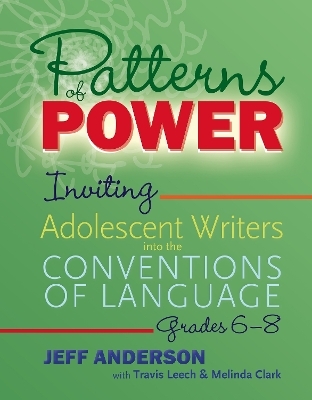
Patterns of Power, Grades 6–8
Stenhouse Publishers (Verlag)
978-1-62531-515-1 (ISBN)
Ready-to-use lesson plan sets that include excerpts from authentic and diverse mentor texts curated for grades 6-8
Real-life classroom examples, tips, and Power Notes gleaned from the authors’ experiences that can be applied to any level of writer
Resources, including a Patterns of Power Planning Guide and musical soundtracks, to use in classroom instruction or as handouts for student literacy notebooks
Patterns of Power, Grades 6-8 provides a simple classroom routine that is structured in length and approach, but provides teachers flexibility in choosing the texts, allowing for numerous, diverse voices in the classroom. The practice helps students build cognitive recognition and provides a formative assessment for teachers on student progress. With these short lessons, students will gain confidence and move beyond limitation to produce effortless writing in your class and beyond. The Patterns of Power series also includes Patterns of Power, Grades 1-5: Inviting Young Writers into the Conventions of Language; Patterns of Power en Español, Grades 1-5: Inviting Bilingual Writers into the Conventions of Spanish; Patterns of Power, Grades 9-12: Teaching Grammar Through Reading and Writing; and Patterns of Wonder, Grades PreK-1: Inviting Emergent Writers to Play with the Conventions of Language.
For over thirty years, Jeff Anderson has inspired writers and teachers of grades K-8 with the power and joy of the writing and grammar. He has written eight books for Stenhouse Publishers. He also writes middle-grade novels. Travis Leech, coauthor of Patterns of Power: Inviting Adolescent Writers into the Conventions of Language, is currently a middle school instructional coach in Northside Independent School District in San Antonio, TX. He has thirteen years of experience in education, including teaching middle school English Language Arts and as a gifted and talented specialist. He has presented about engaging literacy practices and technology integration at the district, regional, and state levels. Melinda Clark, coauthor of Patterns of Power: Inviting Adolescent Writers into the Conventions of Language, is currently the Academic Program Coordinator at John Jay High School in San Antonio, Texas. She has 31 years experience in education, including teaching middle school and high school English Language Arts, instructional coaching, independent consulting, and presenting at the district, regional, and state levels.
Introduction; Part 1: Getting Started with the Patterns of Power Process; 1: Into Planning: What Do You Need to Do Before Teaching the Invitations?; 2: Into the Classroom: How Do You Teach Conventions with the Invitation Process?; 3: Into Application: How Do You Nudge Writers to Apply Conventions?; Part 2: Into the Lessons with the Patterns of Power Process; 4: How Do Writers and Readers Use SENTENCES?; 5: Why Do Writers and Readers Need COMPOUND SENTENCES?; 6: How Do Writers and Readers Use COMPLEX SENTENCES?; 7: How Do Writers and Readers Use PHRASES and CLAUSES?; 8: What Does the MOOD of a VERB Do for Writers and Readers?; 9: How Do Writers and Readers Use VERBALS?; 10: What Does PUNCTUATION Do for Writers and Readers?; 11: What Do PRONOUNS Do for Writers and Readers?; 12: How do Writers and Readers Continue Using CAPITALIZATION?; 13: What Other Amazing Things Can Writers and Readers Do?; Conclusion
| Erscheinungsdatum | 16.04.2021 |
|---|---|
| Sprache | englisch |
| Maße | 216 x 279 mm |
| Gewicht | 1052 g |
| Themenwelt | Schulbuch / Wörterbuch |
| Sozialwissenschaften ► Pädagogik ► Schulpädagogik / Grundschule | |
| Sozialwissenschaften ► Pädagogik ► Schulpädagogik / Sekundarstufe I+II | |
| ISBN-10 | 1-62531-515-5 / 1625315155 |
| ISBN-13 | 978-1-62531-515-1 / 9781625315151 |
| Zustand | Neuware |
| Informationen gemäß Produktsicherheitsverordnung (GPSR) | |
| Haben Sie eine Frage zum Produkt? |
aus dem Bereich


